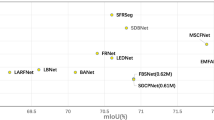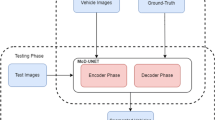Abstract
Visual vehicle exhausts segmentation is a novel and highly challenging task. In this paper, we introduce a lightweight dual-branch vehicle exhausts segmentation network to quickly and accurately infer segmentation masks from multi-interference traffic scenes. Firstly, we propose an encoder-decoder architecture with lightweight residual modules, which is divided into a deep branch for global prediction and a shallow branch for spatial details. Secondly, pyramid attention structure and skip modules are used to expand the receiving range and integrate multi-scale features. Finally, we advance a fusion network to merge the results of two branches so that the entire model can be easily trained end-to-end. To replace the complicated manual annotation, we employ dynamic fluid simulation and computer graphics technology to generate synthetic vehicle exhausts datasets VED. Comprehensive experiments on our synthetic and real datasets demonstrate that the proposed network outperforms existing segmentation networks in terms of speed and accuracy trade-off. Vehicle exhausts segmentation results on real videos are also appealing.












Similar content being viewed by others
References
CBCL Street Scenes (2020) [Online] http://cbcl.mit.edu/software-datasets/streetscenes/
Chen Y, Liu L, Tao J, Xia R, Chen X (2020) The improved image inpainting algorithm via encoder and similarity constraint. Visual Comput (3)
Chen L, Papandreou G, Kokkinos I, Murphy K, Yuille AL (2018) DeepLab: Semantic image segmentation with deep convolutional Nets, atrous convolution, and fully connected CRFs. IEEE Trans Pattern Anal Machine Intell 40 (4):834–848
Chen Y, Tao J, Liu L, Xiong J, Yang K (2020) Research of improving semantic image segmentation based on a feature fusion model. J Ambient Intell Human Comput (2)
Chen Y, Wang J, Chen X, Zhu M, Yang K, Wang Z, Xia R (2019) Single-image super-resolution algorithm based on structural self-similarity and deformation block features. IEEE Access 58791–58801
Chen Y, Wang J, Liu S, Chen X, Xiong J, Xie J, Yang K (2019) Multiscale fast correlation filtering tracking algorithm based on a feature fusion model. Concurr Comput Pract Exp
Chen Y, Wang J, Xia R, Zhang Q, Cao Z, Yang K (2019) The visual object tracking algorithm research based on adaptive combination kernel. Ambient Intell
Chen Y, Xu W, Zuo J (2019) The fire recognition algorithm using dynamic feature fusion and IV-SVM classifier. Cluster Comput 22(3):7665–7675
Chen L, Zhu Y, Papandreou G, Schroff F, Adam H (2018) Encoder-decoder with atrous separable convolution for semantic image segmentation. In: ECCV
Filonenko A, Hernandez DC, Jo KH (2017) Fast smoke detection for video surveillance using cuda. IEEE Trans Indust Inform 1–1
Fu J, Liu J, Tian H, Li Y, Bao Y, Fang Z et al (2019) Dual attention network for scene segmentation. In: IEEE/CVF conference on computer vision and pattern recognition (CVPR). IEEE
He K, Zhang X, Ren S, Sun J (2016) Deep residual learning for image recognition. In: CVPR, pp 770–778
Home of the Blender Project–Free and 3D Creation Software (2018) Accessed 8 Jul 2018. [Online]. https://www.blender.org/
Howard A, Zhu M, Chen B, Kalenichenko D, Wang W, Weyand T, Adam H (2017) MobileNets: Efficient convolutional neural networks for mobile vision applications. arXiv: Comput Vision Pattern Recognit
Huang H, Kalogerakis E, Chaudhuri S, Ceylan D, Kim VG, Yumer E (2017) Learning local shape descriptors from part correspondences with multiview convolutional networks. Int Conf Comput Graphics Interact Techniq
Kajiya JT, Herzen BPV (1984) Ray tracing volume densities. Conference on computer graphics & interactive techniques. ACM
Li X, Chen Z, Wu QM, Liu C (2020) 3D parallel fully convolutional networks for real-time video wildfire smoke detection. IEEE Trans Circ Syst Video Technol 30(1):89–103
Li H, Xiong P, Fan H, Sun J (2019) DFANet: Deep feature aggregation for real-time semantic segmentation. In: CVPR. 2019, pp 9522–9531
Na Z, Huiqin W, Yan HU (2017) Smoke image segmentation algorithm based on rough set and region growing. J Front Comput Sci Technol
Pascal Visual Object Classes (VOC) (2012) [Online]. http://host.robots.ox.ac.uk/pascal/VOC/
Paszke A, Chaurasia A, Kim S, Culurciello E (2017) ENet: A deep neural network architecture for real-time semantic segmentation. arXiv: Comput Vision Pattern Recognit
Poudel RP, Bonde U, Liwicki S, Zach C (2018) ContextNet: Exploring context and detail for semantic segmentation in real-time. In: BMVC
Poudel RP, Liwicki S, Cipolla R (2019) Fast-SCNN: Fast semantic segmentation network. In: BMVC
Pyykonen P, Peussa P, Kutila M, Fong K (2016) Multi-camera-based smoke detection and traffic pollution analysis system. IEEE Int Conf Int Comput Commun Process
Romera E, Alvarez JM, Bergasa LM, Arroyo R (2018) ERFNet: Efficient residual factorized ConvNet for real-time semantic segmentation. IEEE Trans Intell Transport Syst 19(1):263–272
Ronneberger O, Fischer P, Brox T (2015) U-net: Convolutional networks for biomedical image segmentation. In: International conference on medical image computing and computer-assisted intervention, pp 234–241
Sandler M, Howard A, Zhu M, Zhmoginov A, Chen L (2018) Mobilenetv2: Inverted residuals and linear bottlenecks. In: CVPR, pp 4510–4520
Shelhamer E, Long J, Darrell T (2017) Fully convolutional networks for semantic segmentation. IEEE Trans Pattern Anal Machine Intell 39(4):640–651
Simonyan K, Zisserman A (2014) Very deep convolutional networks for large-scale image recognition. In: CVPR
Sun L, Ma C, Chen Y, Zheng Y, Shim HJ, Wu Z, Jeon B (2019) Low rank component induced spatial-spectral kernel method for Hyperspectral image classification. IEEE Trans Circ Syst Video Technol 1–1
Sun K, Xiao B, Liu D, Wang J (2019). In: IEEE/CVF conference on computer vision and pattern recognition (CVPR). IEEE. Deep high-resolution representation learning for human pose estimation
Tao H (2019) Contour-based smoky vehicle detection from surveillance video for alarm systems. Signal Image Video Process 13(2):217–225
Tao H, Lu X (2018) Smoky vehicle detection in surveillance video based on gray level co-occurrence matrix. Tenth Int Conf Digital Image Process
Tao H, Lu X (2018) Smoky vehicle detection based on range filtering on three orthogonal planes and motion orientation histogram. IEEE Access 57180–57190
Tao H, Lu X (2018) Smoky vehicle detection based on multi-scale block tamura features. Signal Image Video Process
Tao H, Lu X (2018) Automatic smoky vehicle detection from traffic surveillance video based on vehicle rear detection and multi-feature fusion. IET Intell Transp Syst 13(2)
Tao H, Lu X (2019) Smoke vehicle detection based on multi-feature fusion and hidden markov model. J Real-Time Image Process
Tian H, Li W, Wang L, Ogunbona P (2014) Smoke detection in video: An image separation approach. Int J Comput Vis 106(2):192–209
Tsafack N, Sankar S, Abd-El-Atty B, Kengne J, El-Latif AAA (2020) A new chaotic map with dynamic analysis and encryption application in internet of health things. IEEE Access PP(99):1–1
Udacity (2020) [Online]. https://www.udacity.com/self-driving-car/
Wang H, Chen Y (2019) A smoke image segmentation algorithm based on rough set and region growing. J Forest Sci 65(8):321–329
Wang Y, Zhou Q, Liu J, Xiong J, Gao G, Wu X, Latecki L J (2019) Lednet: A lightweight encoder-decoder network for real-time semantic segmentation. In: ICIP, pp 1860–1864
Xu G, Zhang Y, Zhang Q, Lin G, Wang Z, Jia Y, Wang J (2019) Video smoke detection based on deep saliency network. Fire Safety J 277–285
Yang J, Gaohua L, Jinjun W, Jun F, Yongming Z (2016) Early video smoke segmentation algorithm based on saliency detection and gaussian mixture model. Comput Eng 42(2):206–209
Yuan F, Zhang L, Xia X, Huang Q, Li X (2020) A wave-shaped deep neural network for smoke density estimation. IEEE Trans Image Process 2301–2313
Yuan F, Zhang L, Xia X, Wan B, Huang Q, Li X (2019) Deep smoke segmentation. Neurocomputing 248–260
Zhao Y (2015) Candidate smoke region segmentation of fire video based on rough set theory. J Electric Comput Eng
Zhao H, Shi J, Qi X, Wang X, Jia J (2017) Pyramid scene parsing network. computer vision and pattern recognition. In: CVPR, pp 6230–6239
Acknowledgements
This work is supported by the Key Research and Development Program Project Foundation of Anhui Province, China, under Grant No. 1804a09020049.
Author information
Authors and Affiliations
Corresponding author
Ethics declarations
Conflict of Interests
The authors declare that they have no conflict of interest.
Additional information
Publisher’s note
Springer Nature remains neutral with regard to jurisdictional claims in published maps and institutional affiliations.
Rights and permissions
About this article
Cite this article
Sheng, C., Hu, B., Meng, F. et al. Lightweight dual-branch network for vehicle exhausts segmentation. Multimed Tools Appl 80, 17785–17806 (2021). https://doi.org/10.1007/s11042-021-10601-z
Received:
Revised:
Accepted:
Published:
Issue Date:
DOI: https://doi.org/10.1007/s11042-021-10601-z




